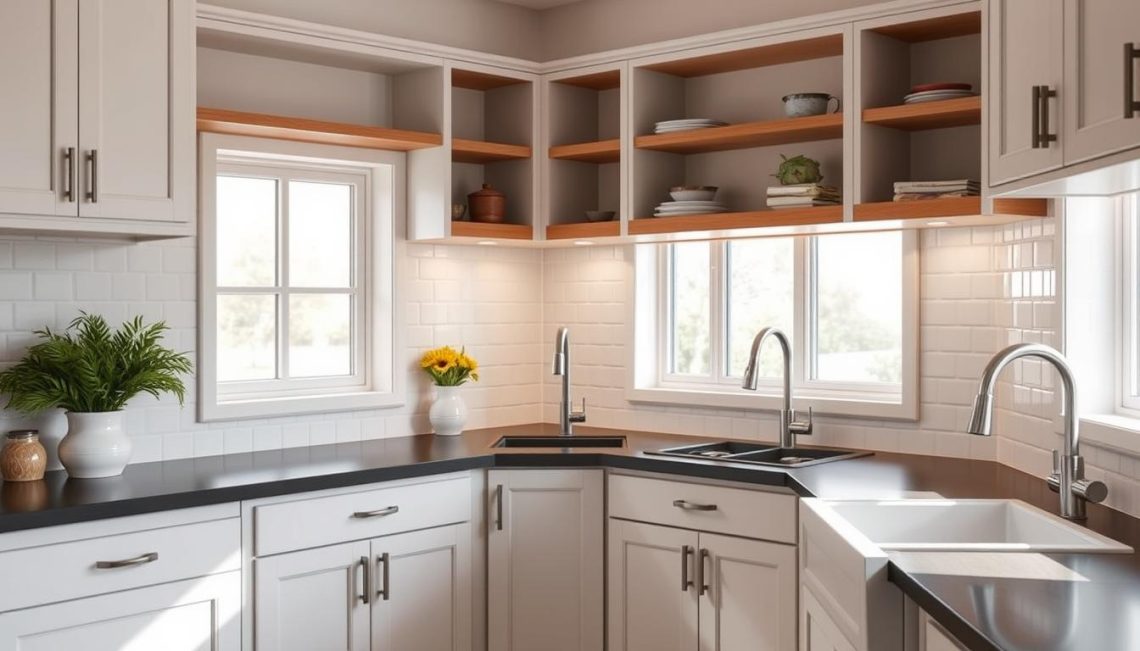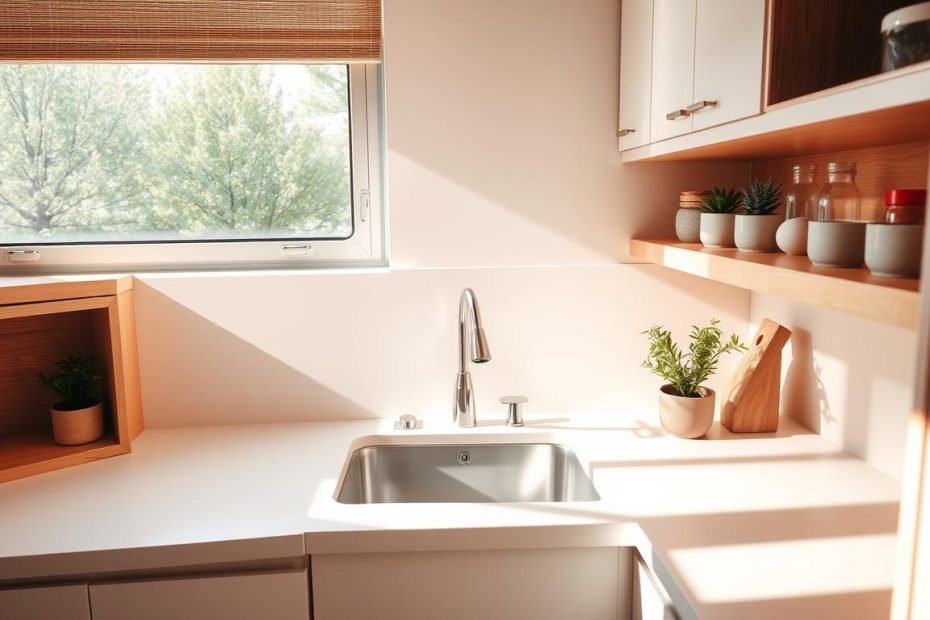When it comes to designing an efficient kitchen, every inch counts. For homeowners with smaller kitchens, finding ways to maximize space without sacrificing style is a top priority. That’s where a corner kitchen sink comes in – a clever design solution that can help create a more streamlined workflow and enhance the overall aesthetic of the kitchen.
By incorporating a sink into the corner of the kitchen, homeowners can free up valuable counter space and create a more open feel. This design choice is not only practical but also visually appealing, making it an attractive option for those looking to optimize their kitchen’s layout.
We will explore how this design can benefit homeowners and provide a more efficient kitchen experience.
Why Choose a Corner Kitchen Sink for Your Home
For kitchens where space is at a premium, a corner kitchen sink offers a practical and stylish solution. By utilizing the often-wasted corner space, homeowners can create a more efficient kitchen layout.
Space-Saving Advantages in Small Kitchens
Corner kitchen sinks are particularly beneficial in small kitchens where every inch counts. They help to:
- Maximize corner space that would otherwise be difficult to use.
- Create a more open feel by keeping the main countertops clear.
- Enhance workflow by providing an additional workspace.
Design Versatility and Aesthetic Appeal
Corner kitchen sinks come in a variety of styles and materials, making it easy to find one that complements your kitchen design. Whether you’re going for a modern look or a more traditional aesthetic, there’s a corner sink to suit your needs.
Ergonomic Benefits for Daily Use
The ergonomic benefits of a corner kitchen sink should not be overlooked. By placing the sink in a corner, you can create a more natural workflow that reduces strain on your back and shoulders.
Selecting the Perfect Corner Kitchen Sink
When it comes to selecting a corner kitchen sink, several factors come into play to ensure you make the perfect choice. The right sink can enhance both the functionality and aesthetic appeal of your kitchen.
Material Options: Stainless Steel, Composite, and Cast Iron
The material of your corner kitchen sink is crucial for its durability and maintenance. Stainless steel sinks are popular for their resistance to corrosion and ease of cleaning. Composite sinks, made from materials like granite or quartz, offer a durable and stylish option. Cast iron sinks, known for their heavy-duty construction, provide a classic look but require more maintenance.
| Material | Durability | Maintenance | Aesthetic Appeal |
|---|---|---|---|
| Stainless Steel | High | Low | Modern |
| Composite | High | Medium | Stylish |
| Cast Iron | Very High | High | Classic |
Single vs. Double Bowl Configurations
The configuration of your sink, whether single or double bowl, depends on your kitchen’s layout and your personal preference. Single bowl sinks offer a spacious area for large items, while double bowl sinks provide versatility for multitasking.
Undermount, Drop-in, and Farmhouse Mounting Styles
The mounting style of your sink affects its appearance and installation process. Undermount sinks provide a sleek, modern look. Drop-in sinks are easy to install and replace. Farmhouse sinks, with their apron front, add a rustic charm to your kitchen.

Matching Faucets and Accessories
To complete your corner kitchen sink setup, choosing the right faucet and accessories is essential. Consider the finish, functionality, and compatibility with your sink to create a cohesive look.
By carefully considering these factors, you can select a corner kitchen sink that not only meets your practical needs but also enhances the overall look of your kitchen.
Step-by-Step Corner Kitchen Sink Installation
Let’s dive into the process of installing a corner kitchen sink, a project that can enhance your kitchen’s efficiency. Installing a corner kitchen sink requires careful planning, the right tools, and a bit of DIY know-how.
Essential Tools and Materials Checklist
Before starting your sink installation, ensure you have all the necessary tools and materials. This includes a sink, faucet, drain assembly, mounting clips, silicone sealant, and plumbing supplies. Having everything ready will streamline the process.
| Tool/Material | Description |
|---|---|
| Sink | Corner kitchen sink unit |
| Faucet | Compatible faucet for your sink |
| Drain Assembly | Includes drainpipe and fittings |
Measuring and Preparing the Corner Cabinet
Accurate measurements are crucial. Measure the corner cabinet space to ensure your sink fits perfectly. Prepare the cabinet by removing any obstructions and ensuring it’s clean and dry.
Creating the Sink Cutout Safely
Safety first: Wear protective gear, including gloves and goggles. Use a jigsaw or circular saw to create the sink cutout, following the manufacturer’s template or guidelines.
Securing the Sink and Sealing Edges
Carefully lower the sink into the cutout and secure it with mounting clips. Apply silicone sealant around the edges to prevent leaks and ensure a watertight seal.
Connecting Drain and Water Supply Lines
Connect the drain assembly to the sink and the water supply lines to the faucet. Ensure all connections are tight and leak-free.
Testing and Troubleshooting Common Issues
Turn on the water supply and check for leaks. Test the drain by running water through it. Troubleshoot any issues that arise, such as leaks or poor drainage.
By following these steps, you’ll successfully install your corner kitchen sink, enhancing your kitchen’s functionality and aesthetic appeal.
Caring for Your Corner Sink to Ensure Longevity
To keep your Corner Kitchen Sink in excellent condition, regular sink maintenance is crucial. We recommend cleaning your sink daily with mild soap and water to prevent grime buildup. For tougher stains, a mixture of baking soda and water can be effective without damaging the sink’s surface.
Proper kitchen care involves avoiding harsh chemicals and abrasive cleaners that can harm the sink’s material. Whether your sink is made of stainless steel, composite, or cast iron, gentle cleaning products are best. Regularly checking and maintaining the sink’s drain and faucet can also enhance its longevity.
By following these simple care tips, you can ensure your Corner Kitchen Sink remains functional and aesthetically pleasing for years to come. Regular maintenance not only prolongs the sink’s lifespan but also keeps it looking its best, contributing to the overall beauty of your kitchen.
